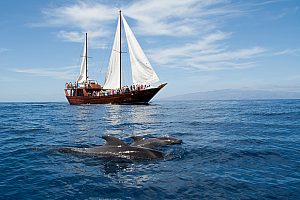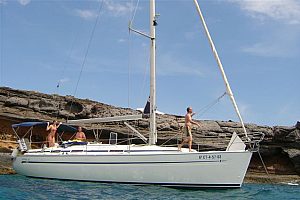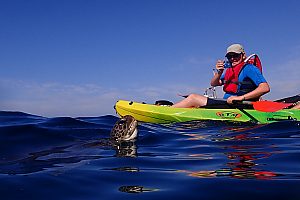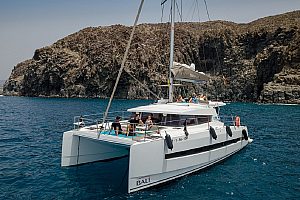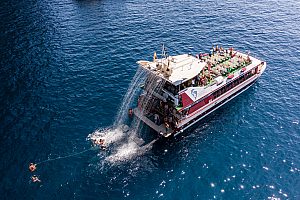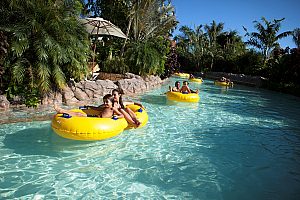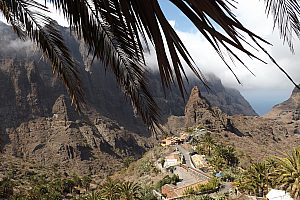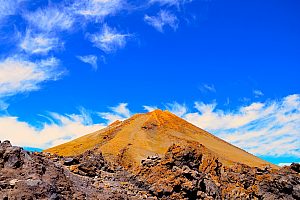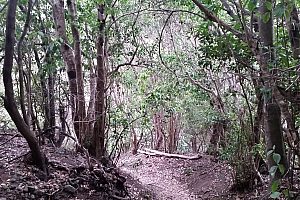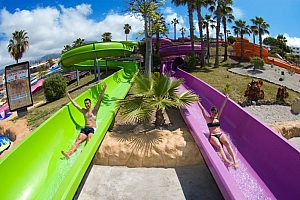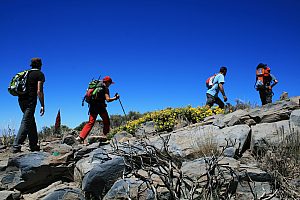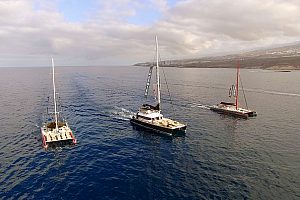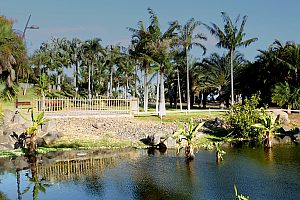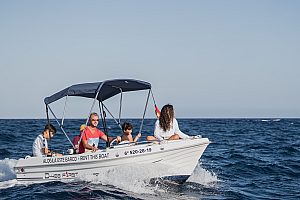Sights not to be missed in Tenerife
The special fascination for the island and a holiday in Tenerife comes from its nature, which shows itself in unique contrasts. Thus, many of the most important Tenerife sights are to be found in the varied natural landscape - and are often connected with the volcanic origin of the Canary Island.
Attraction 1
Teide Natural Park

One of the most important and largest attractions is the El Teide National Park, which covers an area of 19,000 hectares in the centre of the island. Founded in 1954, it is the largest and oldest national park in the Canary Islands. Its spectacular volcanic landscapes have been included in the UNESCO World Heritage List since 2007. The Teide National Park can be reached by bus (span. Guaga) or car:
By bus or car to the Natural park El Teide
Arrival by bus:- from Puerto de la Cruz, line 348
- from Costa Adeje, line 342
- from the north via road TF-21 La Orotava-Granadilla or via road TF-24 La Laguna-El Portillo
- from the south via road TF-21
- from the west via road TF-38 Boca Tauce-Chío
The TF-24 road, which runs from San Cristóbal de La Laguna in the north-east to the National Park, is a popular tourist route. On this unique route through Cañadas, the volcanic landscape, full of contrasts, is as breathtaking as it is diverse! A highlight are the red, up to 3m high Wildprets viper's heads, which draw the area in spring and let you experience a special play of colours! They are therefore also one of the landmarks of the island of Tenerife.
In the National Park El Teide you can expect many activities to discover this natural wonder for yourself. Especially worthwhile is a cable car ride up to the highest mountain of the national park, the Pico del Teide (3.718 m), with the Teleférico del Teide. After an eight-minute ascent, which is an experience in itself, you are at an altitude of 3,555m. From here you can enjoy a spectacular view of the park and its fascinating volcanic landscape! If you are looking for a special challenge, you can dare the ascent to the crater. After a 40-minute walk you will be at the highest point of Spain and on a cloudless day you will have a clear view of Gran Canaria, La Palma, El Hierro, La Gomera and Tenerife itself. However, the ascent has a high degree of difficulty and is only allowed with permission. Depending on the season, you should obtain this from the Central de Reservas one or two months in advance or you can book the Teide Tour including permit.

Far away from the hectic city life in Santa Cruz de Tenerife, Puerto de la Cruz or La Laguna, the most beautiful destinations on Tenerife can be found in the stunning natural landscape. Many of Tenerife's attractions are directly linked to the Pico del Teide, which at 3,718 metres is the highest peak in Spain and the third highest volcano in the world. The Teide, which last erupted in 1798, and the surrounding El Teide National Park offer numerous opportunities to trace the volcanism and the centuries-old history of the island.
Popular destinations in Teide National Park
- Pico Viejo: Next to Mounta Teide, the Mount Viejo is another volcano and the second largest elevation in Tenerife
- Cueva del Viente: Located in Icod de los Vinos on the north coast of Tenerife is the Cueva del Viente volcanic tube. It was formed 27,000 years ago from basalt lava from the first phase of the eruption of the Pico volcano and consists of a huge, net-like labyrinth of underground passages, many of which have not been explored to this day. The volcanic cave can be visited daily with children from 5 years of age - please note the special winter opening hours!
- Roques de Garcia: Below the Teide are the Roques des Garcia, strikingly shaped rock formations of lava rock. The most famous of these rocks is the Roque Cinchado, which is also called the "Stone Tree" or "Finger of God" because of its bizarre shape and is considered the symbol of the island
- Montaña Blanca: Towering over the Cañadas is Montaña Blanca, the third highest peak in Tenerife after Pico del Teide and Pico Viejo, at 2748 metres. The "white mountain" of Tenerife owes its name to the beige colour of the light pumice stone on its surface
- Paisaje Lunar: Ash and pumice deposits formed the Paisaje Lunar, a breathtaking lunar landscape at the southern foot of the Teide. A well-maintained hiking trail with gentle climbs leads up to an altitude of 800 metres, where you can experience the austere beauty of the landscape, bizarre rock formations and a wonderful view from Teide to Vilaflor!
Attraction 2
Excursion in the cities of Tenerife
Nature meets culture: In the cities of Tenerife the impressive natural scenery and lived history of the Canary Islands meet. Many of the most important sights on Tenerife can be found in and around towns on the south and north coast of the island. We will give you an insight into the most popular excursion destinations in the big cities of Tenerife:

Island capital: Santa Cruz de Tenerife
Visiting the capital of a country is an essential must for many tourists. The title of capital of Tenerife is shared by Santa Cruz de Tenerife and Las Palmas de Gran Canaria. As the largest city on the island, where just over 200,000 people live directly by the sea on the northeast coast of Tenerife, there is a lot to discover.

If you are not coming to the capital for an extended shopping tour, a good starting point to explore the city is the Plaza de España. From this square, which is famous for its artificial pond and the war memorial Monumento a Los Caídos, you can reach the charming old town of Santa Cruz. The special charm of the old town is due to the many small squares decorated with flowers, fountains or statues, where locals also gather in the evening.
From the Plaza de España towards the south you will reach the oldest Catholic church in the city, the Nuestra Señora de la Concepción. The church tower, built in the 16th century, is one of the most photographed subjects in Santa Cruz de Tenerife. Another popular place to visit and photograph is the Auditorio, which was completed in 2003. Because of its white, curved roof it reminds of the Sydney Opera House.
If you are looking for relaxation in the capital, you will find it at Parque Marítimo - a swimming pool in the middle of the city - or a few kilometres away at Playa de Las Teresitas. The 1.5 kilometre long beach is also popular with locals because of its white, palm-lined sandy beach, reminiscent of the Caribbean. If you visit the Playa de Las Teresitas, you should go a few metres further to the Mirador Las Teresitas - at the viewpoint you have a wonderful view over the old town and the port of Santa Cruz de Tenerife.
Capital of culture: San Cristóbal de la Laguna
Just a few kilometres west of the capital is San Cristóbal de La Laguna. This place, which is only called La Laguna, is also known as the cultural capital of Tenerife and was once one of the most important places of pilgrimage for the indigenous people of the island. However, its historic centre, which is now a UNESCO World Heritage Site, was only built 200 years later, in the 16th century. The cultural and historical value of the city makes La Laguna a city of Tenerife that is well worth a visit, but not for children, who might find the excursion boring.

But if you are looking for cultural diversion, you can stroll through the colourful historic old town, visit the numerous museums, Catholic churches and cathedrals and finally take a break in one of the cosy cafés along the streets and squares. Also worth seeing is the bell tower of the church Iglesia de la Concepción, which is the symbol of the city.
Capital of history: Puerto de la Cruz
A popular excursion destination on Tenerife - not only among British tourists - is Puerto de la Cruz. This town on the north coast of Tenerife is especially popular for classic bathing and beach holidays. But there is much more to discover in the city, where between Playa Martiánez and Plaza del Charco the Canarian life pulsates.

Especially if you are interested in the history of the country during your Tenerife holiday, Puerto de la Cruz has many important places of interest in Tenerife:
- Right next to the Piedras is the Castillo de San Felipe - an old fortress that protected Puerto de la Cruz from pirate attacks in the 17th and 18th centuries. The entrance to the museum of the complex is free of charge
- Another fortress worth seeing is the "Bateria de Santa Barbara", where you can discover an impressive collection of rifles and cannons from the 18th and 19th centuries
- The "Loro Parque" is the biggest zoo and animal park on Tenerife - and the figurehead of the city. Especially for the parrot and parakeet collection, which is known worldwide, many visitors come to Loro Parque
- For plant lovers, the small orchid garden "Sitio Litre Garten" is a popular destination. Surrounded by flowers, at the Koi carp pond you are guaranteed to find relaxation!
- The rock garden "Piedras" or the "Parque Taoro" are also popular, as both gardens offer a wonderful view of Puerto de la Cruz and the sea
- Even though Puerto de la Cruz is located on the Atlantic coast, the swimming pool "Lago Martianez" invites you to swim in the city. The swimming pool has a view of the sea and was designed by the Canarian artist César Manrique
Once in Puerto de la Cruz you should also take a look at the wine growing, because the city is not only surrounded by many banana plantations but also wine plantations. Two of the most famous wine growing areas are Tacoronte-Acentejo and Valle de la Orotava. Connoisseurs should settle down in a bodega and order one of the local wines in addition to traditional Tenerife specialities!
Attraction 3
Exploratory tour from Güímar
A special fascination emanates from Güímar - a small, idyllic village on the south-east coast of Tenerife. The municipality, which is one of the oldest on the Canary Island, attracts many tourists to its lively main street, which is lined with many bars and shops. But many historical and culturally valuable places are the real reason why Güímar is a tourist magnet.
The two churches from the 17th century, the Iglesia del Convento de Santo Domingo and the Iglesia de San Pedro, stand out. The latter is the starting point of the Romería El Socorro - a pilgrimage in which the statue of the Virgin Mary is carried to the beach.
The pyramids of Güímar
However, one of Tenerife's most popular attractions can be found at the upper end of the village, in the Chacona district: the mysterious pyramids of Güímar, which have puzzled researchers for almost 30 years. The first to attract the attention of the Norwegian anthropologist Dr Thor Heyerdahl was the step pyramids. He assumed that the Canary pyramids were related to ancient civilisation, as he recognised architectural construction principles from the Old World. Other researchers, on the other hand, claimed that they were "majanos" - simple piles of stones created by farmers when they cleaned their farmland. During the first excavations, carried out in 1991 by archaeologists from the University of La Laguna (Tenerife) and the FERCO Foundation, remains from the 19th century were found. The Astrophysical Institute of the Canary Islands also found out that the pyramids are oriented towards the winter and summer solstices.
This clarified the mystery surrounding the pyramids of Güímar: it is a form of terraced construction from the 19th century that was used by the Guanches for astronomical observations. Thus, the step pyramids bear witness to life on the Canary Islands in the 19th century and thus have a special cultural and ethnographic value.
Opening hours of the pyramids in Güímar:
daily from 9 am to 4 pm
Especially if you are interested in the Guanche culture, you should make an excursion to Güímar during your holiday in Tenerife. In 1998 Thor Heyerdahl founded the ethnographic park "Pirámides de Güimar", on whose more than 64,000 square metres you can find the pyramids, a museum and auditorium, a botanical garden and many green spaces that invite you to explore.

Malpaís de Güímar
Malpaís de Güímar is another of Tenerife's special attractions, which has been protected since 1987 for its special ecological value. If you are in Tenerife for hiking, you should not miss the tour of the Malpaís de Güímar Nature Reserve. The circular route starts at the port of Puertito de Guimar and leads through the unique volcanic landscape of the Montaña Grande to the coast. You will get an insight into the unmistakable Canary Island flora, as the paths are lined with numerous endemic species, the typical Canary Island spurge or lettuce and comb-shaped beach lilac. Climbing up the viewpoints you will have an impressive view of the solidified lava flows, the Montaña Grande up to the coast.
sunbonoo-tip for an adventure:
Finish your hike across the lava tube and cave area in one of Tenerife's spectacular caves - or at the caving in Cueva Honda. In the grotto, which is only 100 metres long but 5 metres high, you can dare a unique view under the surface of Tenerife! You can also explore Tenerife from a bird's eye view. La Ladera de Güímar is a popular spot for paragliding flights over the Güímar valley.
Puertito de Güimar
An extended day of hiking through the southeast of Tenerife should end at the port of Puertito de Güimar. Because the region around Guimar is a particularly fertile area due to its volcanic origin, there is a lot of agriculture. At the port, in the numerous restaurants and pizzerias you will therefore be able to experience many regional delicacies. Also the aromatic wines are grown in the region.
Last but not least, a visit to the beach in Guimar is also worthwhile: as is characteristic of many beaches in Tenerife, Playa del Cabezo at the harbour and a few kilometres further on Playa de Arriba o las Bajas impress with their deep black colour and coarse-grained sand. The wide promenade of Playa del Cabezo invites you to walk and sunbathe.
Maybe you will discover one of the romantic bathing bays, which are less frequented, and enjoy the sunset with a view of the cliffs. If you are on holiday with your dog, one of the dog beaches of Tenerife can be found here - Playa para perros El Cabezo.
Attraction 4
Candelaria
When looking for the original Canarian life in Tenerife, many people come to Candelaria on the south coast of Tenerife. The city, which is an important Catholic place of pilgrimage in the Canaries, has become a tourist magnet in recent decades. Nevertheless, Candelaria, 15 kilometres from the island's capital, is a quiet, rather indigenous place and other of the sights of Tenerife, which has been able to retain the Canarian flair.

Basílica de Nuestra Señora de Candelaria
The Basílica de Nuestra Señora de Candelaria, or more precisely the black statue of the Virgin Mary "La Marenita" that shelters, is the centre of attention. The church was built in 1959 and dedicated to the Virgin of Mary (Spanish: "Virgen de la Candelaria"). For the Canary Islands, especially their indigenous people (Guanches), the patron saint has a special religious significance, which is why every year on 14 and 15 August believers make a pilgrimage to Candelaria to venerate her.
Traditionally, the Fiestas de Candelaria are held on the evening of the 14th of August, during which a floral offering is made to the Virgin of Mary. In the Plaza de la Basílica there is a staged re-enactment of how the Virgin appeared according to the Guanches. On 15 August, the Assumption of the Virgin, the festivities traditionally end with spectacular fireworks.
Opening hours Basílica de Nuestra Señora de Candelaria:
Monday: 3 pm to 7:30 pm
Tuesday to Sunday: 7:30 am to 7:30 pm
Free entrance
Many tourists visit the Basílica less for religious reasons than for its exceptional architecture. The three-nave, neoclassical church with transept has a splendidly designed chancel and a 25-metre high steeple. Not only if you are on religious tracks and visit the churches and monasteries of Tenerife, Candelaria and the Basílica de Nuestra Señora de Candelaria should be one of your chosen destinations!
Menceyes
Along the paths of Tenerife's cultural heritage, you will not miss the "menceyes" in Candalaria. In the Plaza de la Patrona, on the Candelaria coastal promenade, you will find the nine larger-than-life "Menceyes" - as the Guanche chiefs were called. At the end of the 15th century, at the time of the Spanish conquest, Tenerife was divided into nine regions (so-called "menceyatos"), which were governed by different captains. The nine bronze statues, each of them about 4.5 metres tall, are now reminiscent of the Guanche kings and, according to popular belief, watch over the island of Tenerife. Together with the Basílica, the Menceyes shape the religious scene of Candelaria and are therefore a popular photo motif in Tenerife!

Attraction 5
Icod de los Vinos
Icod de los Vinos owes its name to the wine growing in the region around Puerto de la Cruz. This is why it is a popular destination in Tenerife for wine lovers who want to taste regional wines. Characteristic of the village, which was built in 1501 on steep slopes, are the many terraces where farmers have always cultivated their products. The abundance of water in the area and the surrounding pine forests still favour the cultivation of cereals, sugar cane and above all wine. This is why tourists love relaxing evenings on the terraced vineyards with an unforgettable view of the wide sea of flowers that is also typical for Icod de los Vinos.
Parque del Drago
Before you have been to Icod de los Vinos, you have already heard about one of the most popular sights of Tenerife: the Drago Milenario. This is a world-famous dragon tree, which not only grows to an amazing 16 metres high and up to 20 metres wide, but is also the oldest dragon tree in the world, estimated to be 800 years old. Some scientists even claim that the tree could be 2000 years old. According to popular belief in the Canary Islands, a visit to the Dragon Tree in Icod de los Vinos promises a happy life, which is why the inhabitants of Tenerife regularly visit the tropical plant.
But for tourists, the Parque del Drago, where the Dragon Tree stands, has even more to offer: the butterfly house "Mariposario del Drago", where you can admire hundreds of butterflies, or the replica of a Guanche village.
Be sure to plan a whole day to visit Icod de los Vinos and, if necessary, hire a park guide who can tell you all about the fascinating flora and fauna of Tenerife.
By the way: Only every 15 years in the months July to August a
Opening hours Parque del Drago
April to September daily from 9 am to 8 pm
October to March daily from 10 am to 6 pm
Admission: 5,00 € for adults, children under 8 years 2,50 €, students and seniors 3,00 €

San Marcos
The municipality of Icod de los Vinos also includes the fishing village of San Marcos. Its small bay with a black beach surrounded by steep cliffs is a must to visit if you are on the north coast of Tenerife. It is exactly this protected black natural beach that attracts locals and tourists alike to San Marcos - but it is still an insider tip.
The beach excursion to Playa San Marcos - the "house beach" of Icod de los Vinos - is therefore a must! Especially for a Tenerife holiday with children, the excursion to Playa San Marcos is recommended, because the beach is protected from wind and strong surf by the high rocks - ideal to let children splash around in shallow, calm water! As the beach is also popular among locals, it is recommended to have a beach day during the week. The idyllic impression of the Atlantic Ocean and the rocky backdrop is only spoiled by the many concrete apartment buildings. But this also has the advantage that you will find many small restaurants in San Marcos on the small promenade where you can enjoy freshly caught fish.
Attraction 6
Los Cristianos
Los Cristianos is one of the most popular holiday resorts in Tenerife - undoubtedly because it is located in the sunny south of Tenerife and has a "good weather guarantee". With its two beaches - Playa de Las Vistas and the harbour beach Playa de Los Cristiano - Los Cristianos is the ideal place for a relaxing beach and bathing holiday. At the same time, the municipality is very conveniently located for individual holidaymakers who want to go on a new exploration tour every day: Not only the airport Tenerife South is only 16 kilometres away, but also the harbour with ferry connection to La Gomera, El Hierro and La Palma is very suitable for day trips to the neighbouring islands.

Excursion to La Gomera
The Port of Los Cristianos is one of the busiest and most important ports in Tenerife. Several times a day ferries depart for the coasts of San Sebastian de la Gomera to the east and Valle Gran Rey to the west. In 50 to 60 minutes you can travel to La Gomera for a day trip - all you need is a valid passport or identity card and about 30 to 35 euros for one way. As this is relatively expensive, it is often worthwhile to organise an excursion that includes the crossings, a full day sightseeing programme on La Gomera and often lunch.
On the "wild island of the Canary Islands" you can go on an island tour through the barren mountains, dense forests and along the sunny beaches and discover another of the seven Canary Islands. From the port of Los Cristianos ferries also depart for El Hierro and La Palma.
Ghost town of Abades
Speaking of individual holidays: If you are looking for that certain something in your Tenerife holiday, you should go to Abades. The place on the south coast, between Poris de Abona and La Jaca, is also known as a ghost town. The village came into being when it was built in 1944 as a sanatorium for the many inhabitants of Tenerife suffering from leprosy.
In "Sanatorio de Abona", as it was first called, a hospital, a crematorium, bungalows and administrative buildings and a church in Franco style were built. The construction of the leprosy clinic was already almost completed when a drug against leprosy was developed, which is why the place was never used as a sanatorium. After it had been used as a military station for a long time, many locals settled in the area, who moved into the empty white bungalows with red roofs and enlivened the city. Nevertheless, there are many abandoned ruins in Abades, which makes the ghost town an insider tip among Tenerife's sights. Especially the church, whose large cross can already be seen from the motorway, is worth a visit. The place is not an official tourist place, but it is open to the public and therefore made for an exciting short trip of a different kind!

Attraction 7
Anaga Mountains
For tourists and locals alike, the Anaga mountains in the north-east of the island are a source of particular fascination. As with so many of Tenerife's attractions, this is due to the special climate of the island, which determines the landscape scenery and a mysterious mist that runs through it.
Mercedes forest
On the north-west side, along the ridge of the Anaga Mountains, the Mercedes forest stretches. Its special feature are the evergreen laurel trees, which can reach a height of up to 25 metres. Formerly cut down for its laurel trees, the Mercedes Forest is now partly protected. As a result, the area was only able to develop into the "fairytale forest" as which it is now known beyond the borders of Tenerife. The impression is created by the laurel trees covered with ferns and mosses, whose branches partly grow together into tunnels.
The paths are decorated with Canary Island bellflowers and the Canary Island gentian, while a thick veil of mist obscures the view of the sky. Walk through the Mercedes forest to the Mirador De Jardina or Mirador Cruz del Carmen viewing platforms, from where you can enjoy a fabulous view over the Anaga to La Laguna.

Cruz del Carmen
The Anaga Mountains are one of the most beautiful hiking areas in Tenerife. The routes usually begin in Cruz del Carmen and follow a so-called Camino Real, also known as the "Royal Laurel Way", which used to connect the villages located in the Anaga with the town of La Laguna. Three of the routes that pass through the Anaga are also called "Paths of the Senses" because of their signposting, which invites visitors to discover ancient pieces of the laurel forest by smelling, seeing and touching them. The shortest of the trails is even barrier-free thanks to a catwalk and a walk-on terrace, so that people with physical disabilities do not have to miss out on this sensory experience!
Punta del Hidalgo
The village of Punta del Hidalgo, which rises on a spur into the Atlantic Ocean, borders directly on the Anaga Mountains. A striking landmark of the municipality is the modern 50-metre-high, snow-white lighthouse Faro de Punta del Hidalgo. Another symbol is the "Two brothers and sisters", as the rock formation on the coast is called.
According to a Guanche legend, two young brothers climbed on the rock and at night into the sea because they were forbidden to love each other. Broken by the pain, the mountain split in two with a sorrowful groan. The place is a popular destination for coastal and beach walks, but it is also the starting point for routes that lead to the Anaga mountains, Chinamada or Las Carboneras.
Another, equally special view is revealed at low tide, when locals and tourists alike bathe in the former coral reefs, which are now very popular as natural seawater swimming pools - called "piscina natural" in Spanish. With a little luck you can still find red and brown coral fragments here.

Attraction 8
Teno Mountains
An impressive natural landscape also reveals itself in the Teno mountain nature reserve. Characterised by breathtaking rock formations, blue shimmering water and the seemingly endless view over the Atlantic Ocean.
Masca and Masca Gorge
On some days there are more tourists in Masca than the village of about 100 inhabitants. Most tourists are eager to discover the original Canarian life, as the few inhabitants of the village live at an altitude of 650 to 800 metres on often very steep mountain slopes. At even higher altitudes of the Teno mountains there are not even any footpaths, which is why many species of flora and fauna, some of which are still undiscovered, have been able to settle here undisturbed.
Besides the mountain village of Masca, the Masca Gorge is another reason why tourists come to the Teno Mountains. But the six-hour hike through the narrow "Barranco" to the coast is not for the faint hearted! Since many tourists repeatedly underestimate the difficulty of the route, it was closed for safety reasons. If you want to go on this demanding hike, you should be an experienced hiker and climber or join a guided tour by appointment!

Punta de Teno
No less difficult than a hike through the Masca Gorge is the path to the Punta de Teno peninsula. This headland, which juts out into the Atlantic Ocean in the far west of Tenerife, can only be reached via the poor island road TF-445. With a rental car you may only drive on the road to the cape before 10 am or after 7 pm.
In the summer months from July 1st to September 30th the road is even not passable from 9 am to 8 pm. When you reach Punta de Teno, your first sight is the red-and-white striped lighthouse "Faro de Teno", which marks the westernmost tip of Tenerife. On the trip, the remote, quiet village of Buenavista del Norte is worth a visit! Here you can enjoy a coffee in the seclusion of Plaza de los Remedios or walk along Playa de las Arenas on the coast with views of Tenerife's neighbouring islands.
There are many unspoilt bays and natural swimming pools (span. "charcos"), where you can dive in and relax.
.
Attraction 9
Los Gigantes
Los Gigantes owes its name to the impressive cliffs "Los Acantilado", which are among the steepest cliffs in Europe. The cliffs extend for almost ten kilometres along the coast and shape the picturesque panorama of Los Gigantes. The city has also become one of the most attractive sights in Tenerife for its lively, modern but at the same time typically Canarian character.
Port of Los Gigantes
One of Tenerife's most popular attractions is the port of Los Gigantes. This is also due to the numerous restaurants and cafés that tempt with local specialities. If you are looking for that special restaurant visit, you should go for a meal in one of the restaurants on the hillside. With good food and wine you will have the best view of the cliffs of Los Gigantes in the Pizzeria Mama Lucia or in the grill restaurants Case Edu and Asador Los Acantilados. After the meal the way to one of the most beautiful beaches of Tenerife, the Playa de la Arena, is not far away. In the small bathing bay with an impressive rocky panorama and a black sandy beach, which falls flat into the sea, you can spend a few nice hours. The quiet part of the beach is particularly suitable for a Tenerife holiday with children.
Whale Whatching / Dolphin watching on the southwest coast of Tenerife
Statistically, there is a 95% probability of sightings of pilot whales and dolphins in the wild off the coast of Los Gigantes. Starting from Los Gigantes, you will be taken out to sea in small boats from where up to 26 species of marine mammals can be sighted - including fin whales, orcas and even blue whales.
If you decide to go on a whale watching tour, you should definitely make a sustainable and responsible choice. Many operators offer expertly guided tours, using quiet electric boats to go out and show consideration for whales and dolphins. As the sea on the southwest side of the island is calmer than in the north, you can also take boat trips by kayak or catamaran. Either way, your tour will amaze you at the wonders of nature!

These tours include dolphin and whale watching:
Attraction 10
Garachico
Garachico in the northwest of the Canary Island of Tenerife is a place of particular cultural value. Until the Spanish conquest of the island and its almost complete destruction by a volcanic eruption in the 18th century, Garachico was once the most important port city of Tenerife. Since many religious, historical buildings were rebuilt or restored, the city still bears witness to past golden decades. You do not have to be religiously or particularly interested in history or culture to be captivated by the special sights of Tenerife in Garachico.
Religious and historical buildings
In the 16th and 17th centuries many very influential families settled in Garachico - one of the most important ports in Tenerife. This can still be seen today in the town planning and the architectural style of the Canarian manor houses. The first building in the town was the Iglesia de Santa Ana, but it was severely damaged by a volcanic eruption in 1706. Today's Santa Ana is a reconstruction that houses a Mexican sculpture of the Merciful Jesus and a marble font from the 17th century. The Castillo de San Miguel also paints the picture of Garachico: the fortress was built in 1575 to protect the town, among other things against English privateers, and now functions as a museum. Further evidence of the rich cultural history of the Canary Islands in Garachico:
- The old Franciscan convent: The Convento Concepcionistas Franciscanas impresses with its Mudejar-style wooden ceiling and sacred objects such as the reredos of a Madonna figure that is set up in the convent church.
- The house of the Marquis of Quinta Roja: What is now a cosy country hotel was built in the 16th century by the first Marquis of Quinta Roja. In the following century it was rebuilt and served as accommodation for Franciscan nuns
- The Palace House of the Counts of La Gomera: Also known as Casa de Piedra, the Counts of La Gomera lived in the ashlar house in the 16th century. It was restored after the volcanic eruption of 1706 and still bears witness to Canary Island history today.
- The "Puerta de Tierra" Park: The history of the park also dates back to the 16th century; you can still visit the former city gate through which you reached the port of Garachico. As the archway is lower than the rest of the town, you can easily see how deep the old Garachico was buried by lava in 1706. You can also visit an old wine cellar of the San Juan Degollado estate
El Caletón
The landmark of Garachico is the rock that rises from the Atlantic Ocean in front of the city - the Roque de Garachico. The best view is certainly from El Caletón, the popular natural swimming pool on the coast (span. Piscinas naturales el Caletón). While the lava flows of the volcanic eruption of 1706 had buried almost the entire Garachico, bizarrely shaped natural pools were formed on the coast by the meeting of hot lava and cold Atlantic Ocean. Today the Caletón is used as a natural swimming pool, which is popular with tourists and locals alike, especially in the summer months.

Opening hours El Caletón
daily from 10 am to 9 pm
Entrance free
If you have an eye for architecture, you should stroll through the fishing village of El Caletón. Its narrow streets create a kind of labyrinth, from simple wooden houses to daring constructions on slopes to dizzyingly high houses, revealing the whole range of Canary Island architecture.
The most beautiful beaches on Tenerife you can discover here:
Bestsellers Tenerife
Maybe you are interested in the following activities and tours:
